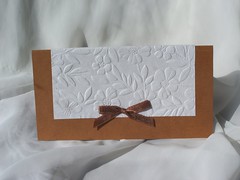I love writing letters. When I moved from NYC to Michigan, I would write my friends all the time, and that has given me a strong passion for written correspondence which I still carry with me. I swoon when I see letters and calling cards in movies. I watched "Rebecca" the other day, and seeing her toss about piles of personalized stationary, it was almost painful.
However, I'm betting that most people haven't written a personal letter in years, if ever. E-mail and texting have overtaken the written word. But the thing about e-mail and texts and all that stuff, it just isn't the same as a letter. It doesn't have that same nostalgia. You can't save an e-mail in a shoebox under your bed, and read it again 20 years later. So I thought I might run down the basics of letter writing for those who haven't done so in a while.
There are only a few elements to a personal letter: the heading, the date, the greeting, the body, the closing or farewell, and the signature. That's it.
The heading contains your address and the address of the recipient. You may leave this off more personal correspondence, but for formal letters (and certainly business letters) these elements should always be present. Where to align these is a little controversial.
The date on a personal letter regardless of formality should always be aligned right.
The greeting or salutation is rather formulaic. "Dear Mrs. de Winter," etc. In a formal letter, you should use Dear. On less formal letters, you can be more personal. I start every single letter, "Hi, Soandso!" All business letters should have the greeting end with a colon. For personal letters, a comma suffices.
The body of the letter should have indented paragraphs or space between paragraph. Otherwise, talk about whatever you like.
The closing or farewell is usually "Sincerely," or some such. Always starts with a capital letter. Always ends with a comma. Always aligned with the date (so if the date is aligned right, then guess where this goes). Signature comes directly beneath this. If you signature is illegible, then printed name beneath that (if you haven't put your name in the header). I am told there is a whole etiquette to how you close a letter. Who gets "Sincerely" and who gets "Faithfully" and some other nonsense. I have no idea (and that should tell you how arcane it must be).
And you're done! For your benefit, I'll try to write a little letter here so you can get the idea!
1234 Madeup Lane
Townsville, SB 13579
Wednesday, August 8, 2007
Manderlay Estate
Cornwall, England
Dear Maxim,
I was delighted to hear that you've found a new love in your life while vacationing in the south of France. There have been many rumors swirling about what type of lady could catch the eye of Maxim de Winter. She must be very lovely. I have recently spoken with Giles and Beatrice, who relay their whole-hearted approval.
I am sorry to be brief, but I wished to say that I greatly look forward to the festivities, and I hope I should get the chance to meet your bride at that time. Thank you for the generous invitation.
[signature]


